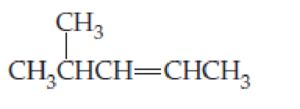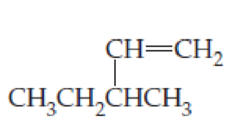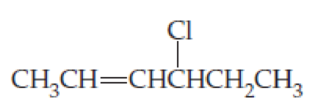
Pearson eText Fundamentals of General, Organic, and Biological Chemistry -- Instant Access (Pearson+)
8th Edition
ISBN: 9780135213759
Author: John McMurry, David Ballantine
Publisher: PEARSON+
expand_more
expand_more
format_list_bulleted
Concept explainers
Textbook Question
Chapter 13, Problem 13.81CP
Which of the following compounds are capable of cis–trans isomerism?



Expert Solution & Answer
Want to see the full answer?
Check out a sample textbook solution
Students have asked these similar questions
What are some topics of interest that neurotoxicologists study? For example, toxin-induced seizures, brain death, and such along those lines?
Could you help me with the explanation of the answer to exercise 15, chapter 1 of Lehinger
Question
Nombramiento de estereoisómeros con dos carbonos quirales utilizando el sistema RS(R,R)El isómero del metilfenidato (Ritalin) se utiliza para tratar el trastorno por déficit de atención con hiperactividad (TDAH).(S,S)El isómero es un antidepresivo. Identifique los dos carbonos quirales en la siguiente estructura. ¿Es este el(R,R)o el(S,S)¿isómero? Dibuja el otro isómero.
Nombramiento de estereoisómeros con dos carbonos quirales utilizando el sistema RS(R,R)El isómero del metilfenidato (Ritalin) se utiliza para tratar el trastorno por déficit de atención con hiperactividad (TDAH).(S,S)El isómero es un antidepresivo.
The reaction A+B → C + D AG°' = -7.3 kcal/mol
can be coupled with which of the following unfavorable reactions to
drive it forward?
A. EFG+HAG° = 5.6 kcal/mol.
B. J+KZ+A AG° = 2.3 kcal/mol.
C. P+RY+DAG° = 8.2 kcal/mol.
D. C + T → V + W AG°' = -5.9 kcal/mol.
E. AN→ Q+KAG°' = 4.3 kcal/mol.
Chapter 13 Solutions
Pearson eText Fundamentals of General, Organic, and Biological Chemistry -- Instant Access (Pearson+)
Ch. 13.2 - Prob. 13.1PCh. 13.2 - Prob. 13.2PCh. 13.2 - What are the IUPAC names of the two alkenes shown...Ch. 13.3 - Prob. 13.4PCh. 13.3 - Prob. 13.5PCh. 13.3 - Prob. 13.6KCPCh. 13.5 - Prob. 13.7PCh. 13.5 - Many biological transformations can be simply...Ch. 13.5 - (a) After the reaction of 11-cis-retinal with...Ch. 13.5 - Prob. 13.2CIAP
Ch. 13.5 - Prob. 13.3CIAPCh. 13.6 - Prob. 13.9PCh. 13.6 - Prob. 13.10PCh. 13.6 - Prob. 13.11PCh. 13.6 - Prob. 13.12PCh. 13.6 - Prob. 13.13PCh. 13.6 - Prob. 13.14KCPCh. 13.6 - Prob. 13.1MRPCh. 13.6 - Prob. 13.2MRPCh. 13.6 - Prob. 13.3MRPCh. 13.7 - Prob. 13.15PCh. 13.7 - Prob. 13.16PCh. 13.8 - Prob. 13.17PCh. 13.8 - Polychlorotrifluoroethylene (PCTFE (Kel-F)) is a...Ch. 13.9 - Prob. 13.19PCh. 13.9 - Prob. 13.20PCh. 13.9 - Prob. 13.21KCPCh. 13.10 - What products will be formed when toluene is...Ch. 13.10 - Prob. 13.23PCh. 13.10 - Prob. 13.4CIAPCh. 13.10 - Prob. 13.5CIAPCh. 13.10 - Prob. 13.6CIAPCh. 13 - Prob. 13.24UKCCh. 13 - Prob. 13.25UKCCh. 13 - Prob. 13.26UKCCh. 13 - Draw the product from reaction of the following...Ch. 13 - Prob. 13.28UKCCh. 13 - Prob. 13.29UKCCh. 13 - Prob. 13.30APCh. 13 - Prob. 13.31APCh. 13 - What family-name endings are used for alkenes,...Ch. 13 - Prob. 13.33APCh. 13 - Prob. 13.34APCh. 13 - Write structural formulas for compounds that meet...Ch. 13 - Prob. 13.36APCh. 13 - Prob. 13.37APCh. 13 - Draw structures corresponding to the following...Ch. 13 - Draw structures corresponding to the following...Ch. 13 - Seven alkynes have the formula C6H10. Draw them,...Ch. 13 - Prob. 13.41APCh. 13 - Prob. 13.42APCh. 13 - There are four different pentenes having the...Ch. 13 - Prob. 13.44APCh. 13 - Prob. 13.45APCh. 13 - Draw line structures for the following alkenes....Ch. 13 - Which compound(s) in Problem 13.43 can exist as...Ch. 13 - Prob. 13.48APCh. 13 - Prob. 13.49APCh. 13 - Which of the following pairs are isomers, and...Ch. 13 - Prob. 13.51APCh. 13 - Prob. 13.52APCh. 13 - Prob. 13.53APCh. 13 - Prob. 13.54APCh. 13 - Prob. 13.55APCh. 13 - Prob. 13.56APCh. 13 - Prob. 13.57APCh. 13 - Prob. 13.58APCh. 13 - Prob. 13.59APCh. 13 - What alkene could you use to make the following...Ch. 13 - Prob. 13.61APCh. 13 - Prob. 13.62APCh. 13 - Prob. 13.63APCh. 13 - Prob. 13.64APCh. 13 - For each of the following reagents, decide whether...Ch. 13 - Prob. 13.66APCh. 13 - Prob. 13.67APCh. 13 - Prob. 13.68APCh. 13 - Salicylic acid (o-hydroxybenzoic acid) is used as...Ch. 13 - The following names are incorrect by IUPAC rules....Ch. 13 - Prob. 13.71CPCh. 13 - Prob. 13.72CPCh. 13 - Prob. 13.73CPCh. 13 - Prob. 13.74CPCh. 13 - Menthene, a compound found in mint plants, has the...Ch. 13 - Prob. 13.76CPCh. 13 - Prob. 13.77CPCh. 13 - Two products are possible when 2-pentene is...Ch. 13 - Ocimene, a compound isolated from the herb basil,...Ch. 13 - Describe how you could prepare the following...Ch. 13 - Which of the following compounds are capable of...Ch. 13 - Prob. 13.82GPCh. 13 - Superglue is an alkene polymer made from the...Ch. 13 - Draw all possible C5H10 alkene isomers having a...
Knowledge Booster
Learn more about
Need a deep-dive on the concept behind this application? Look no further. Learn more about this topic, biochemistry and related others by exploring similar questions and additional content below.Similar questions
- What would be the toxicological endpoints for neurotoxicity?arrow_forwardWhat are "endpoints" in toxicology exactly? Please give an intuitive easy explanationarrow_forwardFura-2 Fluorescence (Arbitrary Unit) 4500 4000 3500 3000 2500 2000 1500 1000 500 [Ca2+]=2970nM, 25°C [Ca2+] 2970nM, 4°C [Ca2+]=0.9nM, 25°C [Ca2+] = 0.9nM, 4°C 0 260 280 300 340 360 380 400 420 440 Wavelength (nm) ← < The figure on the LHS shows the excitation spectra of Fura-2 (Em = 510 nm) in 2 solutions with two different Ca2+ ion concentration as indicated. Except for temperature, the setting for excitation & signal acquisition was identical.< ப a) The unit in Y-axis is arbitrary (unspecified). Why? < < b) Compare & contrast the excitation wavelength of the Isosbestic Point of Fura-2 at 25 °C & 4 °C. Give a possible reason for the discrepancy. < c) The fluorescence intensity at 25 °C & 4 °C are different. Explain why with the concept of electronic configuration. <arrow_forward
- draw in the structure of each amino acid (as L-amino acids) using the Fischer projection style. an example has been included. Draw the structure for glycine, alanine, valine, isoleucine, methionine, proline, phenylalanine, tryptophan, serine, threonine, asparagine, glutamine, lysine, arginine, aspartic acid, glutamic acid, histidine, tyrosine, cysteinearrow_forwarddraw in the structure of each amino acid (as L-amino acids) using the Fischer projection style. an example has been includedarrow_forwarddraw in the structure of each amino acid (as L-amino acids) using the Fischer projection style. an example has been includedarrow_forward
- Draw out the following peptide H-R-K-E-D at physiological pH (~7.4). Make sure toreference table 3.1 for pKa values.arrow_forwardThe table provides the standard reduction potential, E', for relevant half-cell reactions. Half-reaction E'° (V) Oxaloacetate² + 2H+ + 2e malate²- -0.166 Pyruvate + 2H+ + 2e → lactate -0.185 Acetaldehyde + 2H+ + 2e¯ →→→ ethanol -0.197 NAD+ + H+ + 2e--> NADH -0.320 NADP+ + H+ + 2e →→ NADPH Acetoacetate + 2H+ + 2e¯ - -0.324 B-hydroxybutyrate -0.346 Which of the reactions listed would proceed in the direction shown, under standard conditions, in the presence of the appropriate enzymes? Malate + NAD+ oxaloacetate + NADH + H+ Malate + pyruvate oxaloacetate + lactate Pyruvate + NADH + H+ lactate + NAD+ Pyruvate + p-hydroxybutyrate lactate + acetoacetate Acetaldehyde + succinate ethanol + fumerate Acetoacetate + NADH + H+ → B-hydroxybutyrate + NAD+arrow_forwardArrange the four structures in order from most reduced to most oxidized. Most reduced R-CH2-CH3 R-CH2-CH₂-OH R-CH,-CHO R-CH₂-COO Most oxidizedarrow_forward
- for each pair of biomolecules, identify the type of reaction (oxidation-reduction, hydrolysis, isomerization, group transfer, or nternal rearrangement) required to convert the first molecule to the second. In each case, indicate the general type of enzyme and cofactor(s) c reactants required, and any other products that would result. R-CH-CH-CH-C-S-COA A(n) A(n) A(n) A(n) Palmitoyl-CoA R-CH-CH=CH-C-S-CoA ° trans-A-Enoyl-CoA reaction converts palmitoyl-CoA to trans-A2-enoyl-CoA. This reaction requires and also produces Coo HN-C-H CH₂ CH₂ CH CH CH, CH, L-Leucine CH, CH, D-Leucine 8/6881 COO HÌNH: reaction converts L-leucine to D-leucine. This reaction is catalyzed by a(n) H-C-OH H-C-OH C=0 HO-C-H HO-C-H H-C-OH H-C-OH H-C-OH CH,OH Glucose H-C-OH CH,OH Fructose OH OH OH CH-C-CH₂ reaction converts glucose to fructose. This reaction is catalyzed by a(n) OH OH OPO I CH-C-CH H Glycerol Glycerol 3-phosphate H reaction converts glycerol to glycerol 3-phosphate. This reaction requires H,N- H,N H…arrow_forwardAfter adding a small amount of ATP labeled with radioactive phosphorus in the terminal position, [7-32P]ATP, to a yeast extract, a researcher finds about half of the 32P activity in P; within a few minutes, but the concentration of ATP remains unchanged. She then carries out the same experiment using ATP labeled with 32P in the central position, [ẞ-³2P]ATP, but the 32P does not appear in P; within such a short time. Which statements explain these results? Yeast cells reincorporate P; released from [ß-³2P]ATP into ATP more quickly than P¡ released from [y-³2P]ATP. Only the terminal (y) phosphorous atom acts as an electrophilic target for nucleophilic attack. The terminal (y) phosphoryl group undergoes a more rapid turnover than the central (B) phosphate group. Yeast cells maintain ATP levels by regulating the synthesis and breakdown of ATP. Correct Answerarrow_forwardCompare the structure of the nucleoside triphosphate CTP with the structure of ATP. NH₂ 0- 0- 0- ·P—O—P—O—P—O—CH₂ H H H H OH OH Cytidine triphosphate (CTP) Consider the reaction: ATP + CDP ADP + CTP NH 0- 0- 0- ¯0— P—O— P—O—P-O-CH₂ H Η о H H OH OH Adenosine triphosphate (ATP) NH₂ Now predict the approximate K'eq for this reaction. Now predict the approximate AG for this reaction. Narrow_forward
arrow_back_ios
SEE MORE QUESTIONS
arrow_forward_ios
Recommended textbooks for you
 Biology (MindTap Course List)BiologyISBN:9781337392938Author:Eldra Solomon, Charles Martin, Diana W. Martin, Linda R. BergPublisher:Cengage Learning
Biology (MindTap Course List)BiologyISBN:9781337392938Author:Eldra Solomon, Charles Martin, Diana W. Martin, Linda R. BergPublisher:Cengage Learning Human Heredity: Principles and Issues (MindTap Co...BiologyISBN:9781305251052Author:Michael CummingsPublisher:Cengage Learning
Human Heredity: Principles and Issues (MindTap Co...BiologyISBN:9781305251052Author:Michael CummingsPublisher:Cengage Learning Biology: The Dynamic Science (MindTap Course List)BiologyISBN:9781305389892Author:Peter J. Russell, Paul E. Hertz, Beverly McMillanPublisher:Cengage Learning
Biology: The Dynamic Science (MindTap Course List)BiologyISBN:9781305389892Author:Peter J. Russell, Paul E. Hertz, Beverly McMillanPublisher:Cengage Learning Principles Of Radiographic Imaging: An Art And A ...Health & NutritionISBN:9781337711067Author:Richard R. Carlton, Arlene M. Adler, Vesna BalacPublisher:Cengage Learning
Principles Of Radiographic Imaging: An Art And A ...Health & NutritionISBN:9781337711067Author:Richard R. Carlton, Arlene M. Adler, Vesna BalacPublisher:Cengage Learning Human Biology (MindTap Course List)BiologyISBN:9781305112100Author:Cecie Starr, Beverly McMillanPublisher:Cengage Learning
Human Biology (MindTap Course List)BiologyISBN:9781305112100Author:Cecie Starr, Beverly McMillanPublisher:Cengage Learning

Biology (MindTap Course List)
Biology
ISBN:9781337392938
Author:Eldra Solomon, Charles Martin, Diana W. Martin, Linda R. Berg
Publisher:Cengage Learning

Human Heredity: Principles and Issues (MindTap Co...
Biology
ISBN:9781305251052
Author:Michael Cummings
Publisher:Cengage Learning

Biology: The Dynamic Science (MindTap Course List)
Biology
ISBN:9781305389892
Author:Peter J. Russell, Paul E. Hertz, Beverly McMillan
Publisher:Cengage Learning

Principles Of Radiographic Imaging: An Art And A ...
Health & Nutrition
ISBN:9781337711067
Author:Richard R. Carlton, Arlene M. Adler, Vesna Balac
Publisher:Cengage Learning


Human Biology (MindTap Course List)
Biology
ISBN:9781305112100
Author:Cecie Starr, Beverly McMillan
Publisher:Cengage Learning
Macromolecules | Classes and Functions; Author: 2 Minute Classroom;https://www.youtube.com/watch?v=V5hhrDFo8Vk;License: Standard youtube license